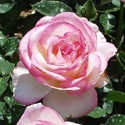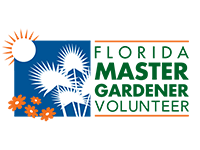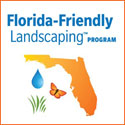Rose FAQ
The most frequently asked questions about roses.
Q: How much should I prune my roses? When should I prune?
A: First year plants should be trimmed very lightly mainly to clean out twiggy, unproductive inside growth. A certain amount of pruning is done all through the year every time a bloom is cut. Any dead or unhealthy canes should be removed immediately as soon as they are seen. Clean sharp clippers are a must. Major pruning of mature rose bushes is done in Central and North Florida from mid-January to mid-February. South Florida follows a different schedule. Old and damaged canes are removed cleanly at the graft union to encourage new growth and improve air circulation. Those left form the framework of the next year's growth, the remaining canes being shortened from 1/3 to 1/2 depending on the height and growth habit of the variety. All old foliage remaining is removed at this time and it is a good practice to spray the plant thoroughly with a basic copper spray to discourage dieback. At this point the garden receives a good fertilizer and the fungicide spray program is begun as soon as new leaves start to appear.
Q: What's the matter with my roses? Lots of the leaves have turned yellow and are dropping off.
A: Lower leaves: Natural attrition from age and maturity, sometimes triggered by heavy rains, excessive watering, or sudden change in weather conditions. Heavy infestation of spider mites, or spray burn from frequent spraying with insecticides.
Upper leaves: Fungus disease, usually Blackspot. Gardeners sometimes do not note the characteristic spots, only that the leaves are yellowing and dropping.
Q: I want to plant a small rose garden, but the man at the nursery told me I shouldn’t plant them as close together as we did back home in Illinois. Was he right and if so, how far apart do I have to put them?
A: Roses in Florida, planted in a bed, should be placed at least 4 ft to 5 ft apart, no more than two plants deep, so that they may be reached for care on either side. The growing season is very long and healthy plants attain a very large size in the course of a year. It is best for the roses and for the caretaker to allow them plenty of room.
Q: If I allow so much room, I won’t be able to put in as many plants, so what would you recommend as the best ones to get?
A: The best choice for our soil and climate is plants that are container grown and grafted on R. Fortuniana rootstock. They are available in many varieties and are well adapted to our growing conditions as well as being more tolerant of nematodes. As the rootball does not have to be disturbed they may be planted at any time of the year as long as they are well watered and cared for. Next choice would be roses on Dr. Huey rootstock which includes more of the well known and established mail order nurseries. Plants bought at discount stores and supermarkets seldom give worthwhile results for the effort involved.
Q: Is there any special way I should prepare the bed before I plant the roses?
A: After clearing out all grass and weeds the soil should be amended with as much organic material as possible. If practical the bed should be raised 8 to 12 inches to provide better drainage. If there is poorly drained soil the base should be dug out first before amendments are added. A pH test to determine soil alkalinity or acidity should be made to find whether lime should be added and if so, how much. Dehydrated manure, sphagnum peat moss, compost if available, commercial bed mix or bone meal or superphosphate in small amounts are all good materials to incorporate into the planting bed. The prepared bed (or separate planting holes) should be well watered and allowed to settle before planting. After planting, the young plants should be staked to protect the tender grafts from sudden wind storms and then heavily mulched with organic mulch such as pine needles, oak leaves or bark. Avoid inorganic mulches such as river rock – the excessive heat generated on bright summer days can be disastrous for young tender surface roots.
Q: That all sounds like a lot of work, but I don’t mind if the end result is worth it. Now, how should I take care of them after they are safely planted?
A: No chemical fertilizer until new growth is well started at least 4 to 6 weeks. Water well and frequently, never let them get too dry. Roses need at least 2 to 3 inches a week especially in hot weather. Use a rain gauge to be sure since summer showers can seem much heavier than they really are. Water in the morning so that the foliage will be well dry before nightfall. After growth has commenced, fertilize with a good rose fertilizer or a premium lawn fertilizer (one with a 16-4-8 analysis). Look for one that is low in chlorine, no more than 5%. Apply lightly to start with, increasing gradually to one cup per month as the plant grows larger. Water well before and after fertilizing. Some good rosarians like to use a feeding soluble fertilizer halfway in between the monthly applications. Have a pH test at least once a year and follow the recommendations as to whether or not to apply lime. Roses grow well between 5.5 and 7.0 but do best between 6.0 and 6.5. Keep blooms trimmed off since this encourages more blooms. Cut your roses to enjoy in your home and to give pleasure to others. Cut stems just above a 5 leaflet leaf, making sure at least two 5 leaflet leaves remain on the stem you have cut from. Cut shorter stems on your plants and leave more foliage on the canes to strengthen the growth.
Q: My neighbor says I have Blackspot on my roses. The new leaves get spots on them and they turn yellow and fall off. What should I do to stop it?
A: Start right away spraying every week or 10 days with a good fungicide. Pick off all the affected leaves you see and dispose of them. Clean up any you see on the ground. Spray thoroughly, wetting on both sides of the leaves with a fungicide such as Dithane M-45, Benomyl or Funginex. Combining any two of these is helpful when the disease is already present. You may have to spray more often until it is under control. Keep removing infected leaves as you see them. Sanitation is important.
Q: The new growth on the roses has some white fuzz on it and some of the buds and new leaves are twisted and distorted. What's wrong and what can we do about it?
A: Your roses have Powdery Mildew. The affected growth cannot recover so trim it off and discard. Then spray with Actidione PM if you can find it, following label directions. Once the mildew is cleared up continue a regular spray with Benomyl and/or Funginex as a preventive. Be sure to cover new growth thoroughly.
Rose rust is rarely seen in Florida and then it usually appears on plants shipped in from out of state. Dithane M-45 and Funginex are recommended for control if it should occur, along with careful sanitation. The same applies to Downy Mildew which has been known to appear at infrequent intervals.
Experience has taught us and many others to maintain a preventive weekly spray program against fungus diseases. Insecticides are used sparingly and only where insects are present.
Virus disease in roses is widespread but usually not a serious concern. It is spread through propagation, with no practical remedy except not propagating infected stock material. Research is being carried on now in several studies and it is hoped to have good results in the near future in availability of virus-free rose plants.
Q: My plants look healthy but the blooms are brownish and some buds don't even open. What's wrong?
A: Your problem is thrips, very tiny insects that attach the buds and new growth, worse in spring but will continue into summer and fall in some areas. They invade the buds just as the sepals separate to show color and once inside are almost impossible to kill. Spray with a hand sprayer just on buds and new growth, using a systemic insecticide such as dimethoate or Orthene and repeating at frequent intervals as long as infestation is bad. Avoid spraying mature foliage if possible.
Q: My rose bushes are covered with ants. Will they damage the plants and how can I get rid of them?
A: The real problem is aphids. Ants only show concentrated interest in roses when aphids are present in quantities enough to produce honeydew to attract them. Spraying to control aphids will usually eliminate the ant problem.
Q: Something is chewing round holes in my rose leaves. I've looked and looked but can't find a caterpillar or anything that could be doing it.
A: You have a leaf cutter bee cutting out little circles of rose leaves to line her nest. Spraying is useless because she does not eat the leaf, only uses it as nesting material. Her damage is minimal.
Q: Our roses look terrible. The leaves look bleached, some have spider webbing and some are dropping. We spray and spray but it doesn't help. What can we do?
A: Spider mites are the most serious insect problem on southern roses. In hot, dry weather they multiply explosively, feeding on the moisture in the leaves and stems and causing defoliation and generally weakening of the plant. Insecticides worsen the situation as the mites quickly build up immunity to common sprays and the preventive treatment is regular drenching of the leaf undersides with a strong jet of plain water, and restricting the use of insecticides on rose foliage. The only specific miticide presently packaged for the home gardener is Kelthane, only mildly effective.
A: Something is ruining my rose buds with little holes all through them. What could it be?
A: Probably it is corn earworms, larvae of the corn borer. They feed on roses too. Spray with Dipel, Thuricide or any spray based on bacillus thuringiensis for good control. It is non-toxic and may be mixed with your regular fungicide spray. If properly placed, excellent control can be achieved with an electric bug killer. It attracts the adult moth before she can deposit her eggs on the rose bud.





